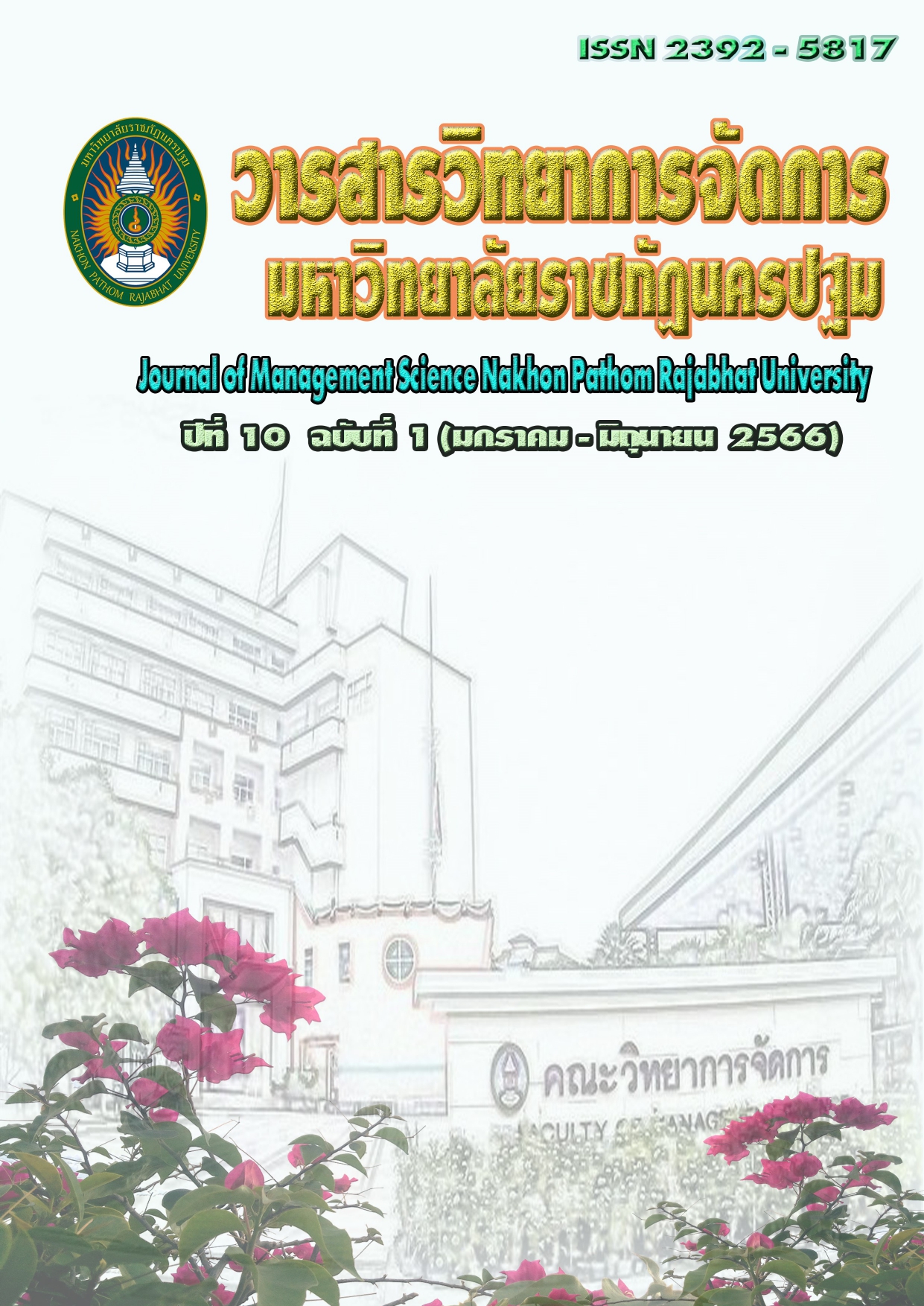การปรับเปลี่ยนจากรัฐบาลอิเล็กทรอนิกส์สู่การเป็นรัฐบาลดิจิทัล : กรณีศึกษา กรมสรรพากรกรมการขนส่งทางบก และกรมทางหลวงชนบท
Main Article Content
บทคัดย่อ
การวิจัยครั้งนี้มีวัตถุประสงค์ 1. เพื่อศึกษาการปรับเปลี่ยนระบบการบริหารราชการไทยจากรัฐบาล
อิเล็กทรอนิกส์สู่การเป็นรัฐบาลดิจิทัลในด้านการส่งมอบบริการสาธารณะ 2. เพื่อศึกษาปัญหาและอุปสรรคที่
ส่งต่อการส่งมอบบริการสาธารณะ 3. เพื่อเปรียบเทียบผลของการปรับเปลี่ยนจากรัฐบาลอิเล็กทรอนิกส์สู่การ
เป็นรัฐบาลดิจิทัลที่ส่งผลการส่งมอบบริการสาธารณะ 4. เพื่อศึกษาแนวทางพัฒนาการให้บริการของภาครัฐที่
ส่งผลต่อการส่งมอบบริหารสาธารณะ
โดยผู้วิจัยใช้เทคนิคการวิจัยเชิงคุณภาพ โดยการสัมภาษณ์เจาะลึกจาก 3 หน่วยงานได้แก่
กรมสรรพากร กรมการขนส่งทางบก และกรมทางหลวงชนบท
ผลการศึกษาพบว่า
1) การปรับเปลี่ยนจากรัฐบาลอิเล็กทรอนิกส์สู่การเป็นรัฐบาลดิจิทัลที่ส่งผลการส่งมอบบริการ
สาธารณะ พบว่า จากเดิมการให้บริการของหน่วยงานภาครัฐจะมีวิธีการให้ผู้รับบริการกรอกแบบฟอร์มเพื่อ
ขอรับบริการและจะต้องเดินทางไปยื่นกับหน่วยงานภาครัฐด้วยตนเอง รูปแบบใหม่ผู้รับบริการสามารถ
ด าเนินการต่างๆผ่านช่องทางไลน์ ท าให้การขอรับบริการมีความสะดวก ความรวดเร็ว ประหยัดเวลา และ
ค่าใช้จ่ายมากยิ่งขึ้น
2) การปรับเปลี่ยนจากรัฐบาลอิเล็กทรอนิกส์สู่การเป็นรัฐบาลดิจิทัลมีปัญหาและอุปสรรค คือ (1)
ปัญหาด้านความพร้อมด้านเทคโนโลยีสารสนเทศและด้านงบประมาณ (2) ปัญหาการสร้างความเข้าใจและ
รับมือกับการเปลี่ยนแปลงของผู้ปฏิบัติงานและประชาชนผู้รับบริการ (3) ปัญหาด้านการบูรณาการเชื่องโยง
ข้อมูลร่วมกันกับหน่วยงานภาคส่วนอื่นๆ (4) ปัญหาข้อจ ากัดทางกฎหมายที่ไม่เอื้อต่อการพัฒนา และ (5)
ปัญหาขาดบุคลากรผู้เชี่ยวชาญด้านการพัฒนาระบบเทคโนโลยีสารสนเทศและบุคลากรด้านการบริการ
3) ผลการเปรียบเทียบการปรับเปลี่ยนจากรัฐบาลอิเล็กทรอนิกส์สู่การเป็นรัฐบาลดิจิทัล ที่ส่งผลการส่ง
มอบบริการสาธารณะระหว่าสามหน่วยงาน พบว่า สอดคล้องกัน และเป็นไปในทิศทางเดียวกันโดยการ
ปรับเปลี่ยน เป็นไปในลักษณะของการปรับปรุงการให้บริการและน าเทคโนโลยีเข้ามาใช้ในการส่งมอบบริการ
สาธารณะแก่ภาคประชาชน ภาคเอกชน และอื่นๆ และมีการบูรณาการเชื่อมโยงข้อมูลระหว่างหน่วยงาน
ภาครัฐ
4) แนวทางพัฒนาการคือ การพัฒนาบุคลากร โดยเน้นการให้ความรู้แก่บุคลากร เนื่องจากปัญหาที่
พบสอดคล้องกันกรณีศึกษาทั้งสามกรณี คือ บุคลากรส่วนใหญ่ขาดทักษะการปฏิบัติงานในลักษณะงานบริการ
แต่ยังขาดแคลนผู้เชี่ยวชาญเฉพาะด้าน ขาดการบริหารจัดการความรู้ยังไม่สามารถน ามาพัฒนาเป็นนวัตกรรมที่
ใช้ร่วมกันขององค์การได้
Article Details

อนุญาตภายใต้เงื่อนไข Creative Commons Attribution-NonCommercial-NoDerivatives 4.0 International License.
ทัศนะและข้อคิดเห็นของบทความที่ปรากฏในวารสารฉบับนี้เป็นของผู้เขียนแต่ละท่าน ไม่ถือว่าเป็นทัศนะและความรับผิดชอบของกองบรรณาธิการ
เอกสารอ้างอิง
ิพวรรณ หล่อสุวรรณรัตน์. (2559). รัฐบาลอิเล็กทรอนิกส์ = E-Government. คณะรัฐประศาสนศาสตร์
สถาบันบัณฑิตพัฒนบริหารศาสตร์.
ธีระ กุลสวัสดิ์. (2555). แผนพัฒนาดิจิทัลของกรมการขนส่งทางบก. วารสารการเมือง การบริหาร และกฎหมาย,
(1),159-195.
ส านักงานพัฒนารัฐบาลดิจิทัล. (2558). รายงานผลการส ารวจเว็บไซต์ของหน่วยงานภาครัฐ ปี พ.ศ.2558.
[ออนไลน์].ค้นเมื่อ 10 ธันวาคม 2565, จาก https://www.dga.or.th/wpcontent/uploads/2015/10/ file_508edcd748da3eb726067c54881614b8.pdf
ส านักงานพัฒนารัฐบาลดิจิทัล. (2559). แผนพัฒนารัฐบาลดิจิทัลของประเทศไทย ระยะ 3 ปี (พ.ศ.2559-
. [ออนไลน์].ค้นเมื่อ 10 ธันวาคม 2565, จาก
https://tdga.dga.or.th/index.php/th/send/9-document/299-3-2559-2561.html
ส านักงานพัฒนารัฐบาลดิจิทัล. (2561). เปลี่ยนผ่านภาครัฐสู่ยุคดิจิทัล. [ออนไลน์].ค้นเมื่อ 10 ธันวาคม 2565,
จาก https://www.dga. or.th/wp-content/uploads/2018/11/
file_74d73af09053ed5071f9aa5c539ba74c.pdf
ส านักวิชาการ ส านักงานเลขาธิการสภาผู้แทนราษฎร. (2559). ภาครัฐไทยกับการก้าวเข้าสู่รัฐบาลดิจิทัล.
[ออนไลน์].ค้นเมื่อ 10 ธันวาคม 2565, จาก http://web.krisdika.go.th/data/outsitedata/
ManagementSystem/pdf/digital01.pdf
Anne Mette Kjær, (1997). Governance. Buckingham: Open University Press.
Chung, Choong-Sik, and Kim, Sung-Bou. (2019). A Comparative Study of Digital Government
Policies, Focusing on E-Government Acts in Korea and the United States. Electronics,
(11), 1362.
Dunleavy, P., Evans, M., and McGregor, C. (2015). Connected government: Towards digital
era governance. University of Canberra. Retrieved December 10, 2022 from
https://www.governanceinstitute.edu.au/magma/media/upload/ckeditor/files/
IGPA%2 0Telstra%20Report%20on%20Digital%20Governance%20for
%20module%204.pdf
Khan,F., Khan,S and Zhang,B. (2010). E-Government Challenges in Developing Countries: A
Case Study of Pakistan. December 10, 2022, Retrieved from
file:///Users/suparatkhaewwisut/Downloads/E-GovernmentChallengesin
DevelopingCountriesACaseStudyofPakistan.pdf
Kosorukov, A. A. (2 0 1 7 ) . Digital government model: Theory and practice of modern public
administration. Journal of Legal, Ethical and Regulatory Issues. 20(3), 1-10.
Mila Gasco-Hernandez. (2020) . Beyond Transparency, Participation, and Collaboration? A
Reflection on the Dimensions of Open Governmental. December 10, 2022, Retrieved
from https://www.tandfonline.com/doi/abs/10.1080/15309576.2020.1734726

